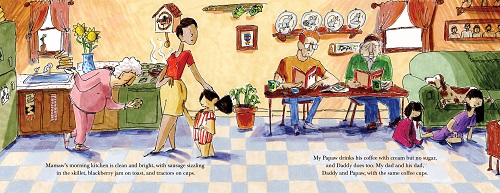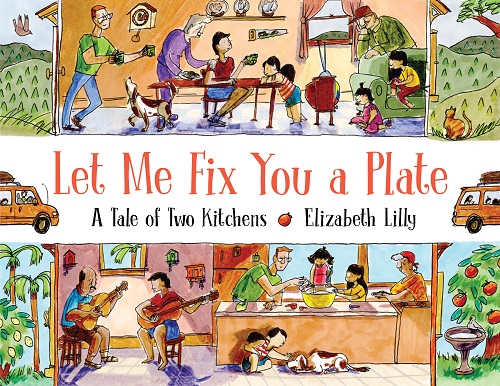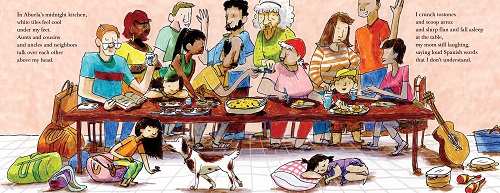Let Me Fix You a Plate: A Tale of Two Kitchens
 August 26th, 2021 by jules
August 26th, 2021 by jules
saying loud Spanish words that I don’t understand.”
(Click spread to enlarge)
You don’t have to wait too much longer now (it will release in early September) to see Elizabeth Lilly’s Let Me Fix You a Plate: A Tale of Two Kitchens (Neal Porter Books). This bighearted tale is one of my favorite 2021 picture books. And how about that title?
This is the story of a family, who packs the car; heads to the mountains of West Virginia; visits with Mamaw and Papaw; packs the car again; and heads to Florida to visit Abuela and Abuelo. They do this once a year, and this time we’re privy to the experience, thanks to our narrator, one of the three children in this family. The story is centered, as you can tell from the title, around the food the families eat together. And everything here is all about the details. With affection, Lilly expertly captures each family and each home with the narrator’s careful observations.
Mamaw and Papaw live in an “old trailer,” nestled in the footfills of the mountains. The walls of their home are adorned with cat plates. Papaw drinks his coffee with cream but not sugar. Mamaw sizzles sausage in the skillet. Their cups have tractors on them. With Mamaw, the children make a banana pudding/vanilla wafer treat, while “the morning mountain fog wrinkles and rolls.” (Ah, as somone who has lived a big chunk of her life in Appalachia, this speaks to me.)

but no sugar, and Daddy does too. My dad and his dad,
Daddy and Papaw, with the same coffee cups.”
(Click spread to enlarge)
Abuela and Abuelo live in “a little orange house on a patch of scratchy grass in Florida.” Abuela greets the family in Spanish when they arrive, as the “hot, sticky air hugs us close.” Many aunts and uncles are there, and they dine on tostones, arroz, and flan. They speak in Spanish, which the narrator doesn’t quite understand (though, eventually, Abuelo tries to teach her). A rosary hangs on the wall. In the morning, the narrator’s mother and Abuela fry corn flour cakes. Readers spend a bit more time in Florida than in West Virginia, and every warm, bustling moment captures this family’s rich heritage and abundant love they have for each other.

Then Abuela runs out and hugs us even closer. ‘Hay comidita adentro. Comense.’
‘There’s food inside. Come and eat,’ she says.”
(Click spread to enlarge)
Tired, the family heads home, their heads filled with what they now miss, listed on the recto of one of the final spreads: “salsa sauage toast tostones ants aunts arepas Abuela naranjas bananas mountains Mamaw cats and fog and scratchy grass.” They head into their own kitchen and make a meal that includes a little bit of both families. (And look closely to see that they also have a cat plate on the wall, as well as the same tiny wooden house for hanging keys that Abuela and Abuelo have in their home.)

Mommy’s midnight kitchen has bright lights and warm wood floors, plaintain pressers next to potato mashers. Outside, our windows glow like gems seen by sleepy passing cars. Inside there’s warm, soft talk and air that smells like waffles. Daddy works the iron, Mommy forks waffles onto plates, and their three little pollitos,
hungry little chicks, gobble them up …”
(Click spread to enlarge)
Lilly renders this in pen-and-ink, colored pencils, and markers. She has a nimble, boundlessly energetic line (the book seems to be all movement; nothing is ever static) and often leans on jewel tones — rich blues, greens, coppers, and garnets — to animate these worlds, bringing in lighter hues for the visit to sunny Florida. These are spreads to pore over. Look for the quiet moments: At their greeting, the narrator’s father and Mamaw (his own mother) give one another a tender hug. After first arriving at Abuela’s and Abuelo’s, the youngest sibling sleeps on the kitchen floor (with its cool white tiles) on a pillow, while the family bustles around her. On one spread, notice the narrator balance an orange on her head as Abuelo heads out with her in the morning.
I think of a 1998 piece for the Horn Book by Karla Kuskin, in which she wrte about art that is “glossy … with little either personal or unique to recommend it.” Well, meet its antidote in this book. Lilly’s exceedingly relaxed linework keeps anything from being too precious or, as Kuskin might say, glossy. And it could never be mistaken as any other illustrator’s; it’s 110% Elizabeth-Lilly. (She notes, too, on the jacket-flap bio that she also grew up in a mixed family — with a Colombian mother and American father.)
Remember when Elizabeth visited 7-Imp as an up-and-coming artist, by the way? If you missed her picture book debut, that is here. I can’t wait to see what she does next.

LET ME FIX YOU A PLATE: A TALE OF TWO KITCHENS. Text and illustrations copyright © 2021 by Elizabeth Lilly. Illustrations reproduced by permission of the publisher, Neal Porter Books / Holiday House, New York.

